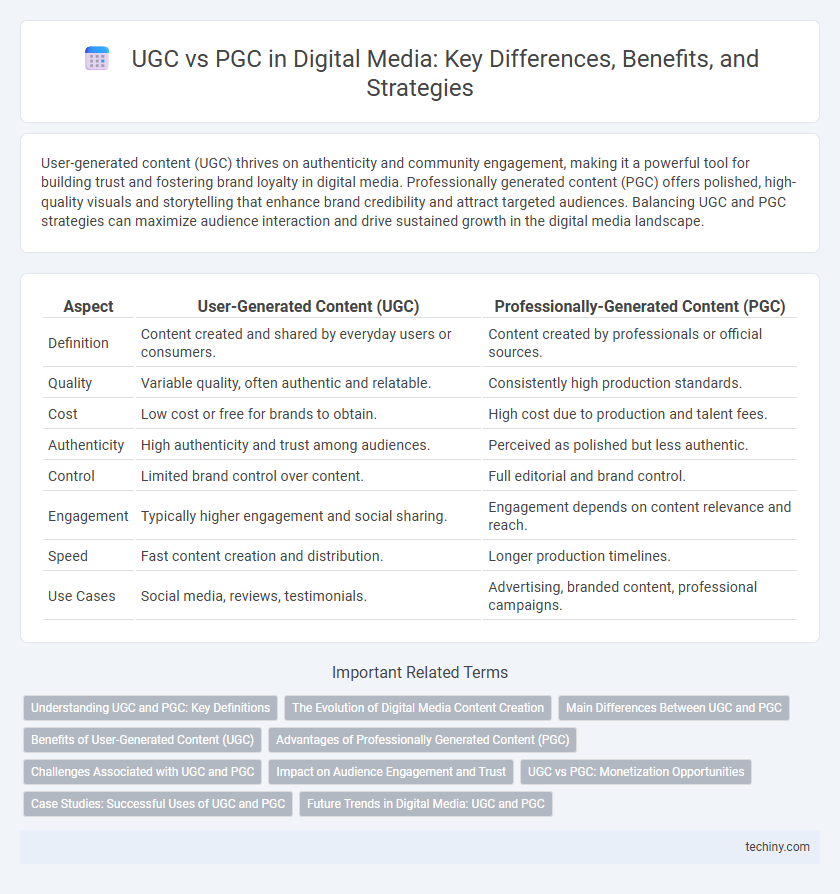User-generated content (UGC) thrives on authenticity and community engagement, making it a powerful tool for building trust and fostering brand loyalty in digital media. Professionally generated content (PGC) offers polished, high-quality visuals and storytelling that enhance brand credibility and attract targeted audiences. Balancing UGC and PGC strategies can maximize audience interaction and drive sustained growth in the digital media landscape.
Table of Comparison
| Aspect | User-Generated Content (UGC) | Professionally-Generated Content (PGC) |
|---|---|---|
| Definition | Content created and shared by everyday users or consumers. | Content created by professionals or official sources. |
| Quality | Variable quality, often authentic and relatable. | Consistently high production standards. |
| Cost | Low cost or free for brands to obtain. | High cost due to production and talent fees. |
| Authenticity | High authenticity and trust among audiences. | Perceived as polished but less authentic. |
| Control | Limited brand control over content. | Full editorial and brand control. |
| Engagement | Typically higher engagement and social sharing. | Engagement depends on content relevance and reach. |
| Speed | Fast content creation and distribution. | Longer production timelines. |
| Use Cases | Social media, reviews, testimonials. | Advertising, branded content, professional campaigns. |
Understanding UGC and PGC: Key Definitions
User-Generated Content (UGC) refers to any form of content, such as videos, images, reviews, or posts, created and shared by consumers or users rather than brands or professionals. Professionally-Generated Content (PGC) is produced by experts, marketers, or brands with a strategic intent to engage audiences and maintain consistent quality standards. Understanding the distinctions between UGC and PGC is crucial for digital media strategies, as UGC often drives authenticity and community engagement, while PGC ensures brand control and polished messaging.
The Evolution of Digital Media Content Creation
The evolution of digital media content creation has shifted the balance between User-Generated Content (UGC) and Professionally Generated Content (PGC), with UGC accelerating due to widespread social media platforms and accessible creation tools. UGC fosters authentic engagement and community-driven narratives, while PGC maintains high production values and brand consistency essential for targeted marketing. This dynamic interplay shapes digital ecosystems, influencing audience behavior, content distribution strategies, and the monetization models of online media.
Main Differences Between UGC and PGC
User-Generated Content (UGC) is created by everyday users and often reflects authentic, diverse perspectives with lower production quality. Professionally-Generated Content (PGC) is produced by experts or companies, emphasizing high-quality, polished, and brand-aligned material. The main differences lie in their authenticity, production value, and the level of control or editorial oversight applied.
Benefits of User-Generated Content (UGC)
User-Generated Content (UGC) enhances brand authenticity by showcasing genuine customer experiences, increasing trust and engagement across digital media channels. UGC reduces content creation costs while providing a diverse range of perspectives that resonate with target audiences. This organic form of content boosts SEO performance and drives higher conversion rates compared to traditional Professional-Generated Content (PGC).
Advantages of Professionally Generated Content (PGC)
Professionally Generated Content (PGC) ensures high-quality production values, including polished visuals, expert storytelling, and consistent branding that boost audience trust and engagement. Brands leveraging PGC achieve greater control over messaging and compliance, minimizing risks associated with misinformation or off-brand content. PGC's strategic use of data-driven insights enhances content effectiveness, driving higher conversion rates and ROI compared to User Generated Content (UGC).
Challenges Associated with UGC and PGC
User-generated content (UGC) faces challenges such as inconsistent quality, lack of content control, and potential copyright infringements, which can impact brand reputation and audience trust. Professionally generated content (PGC) often demands higher production costs and longer timelines, limiting scalability and real-time engagement. Balancing authentic community involvement in UGC with the polished professionalism of PGC remains a strategic challenge for digital media marketers and platforms.
Impact on Audience Engagement and Trust
User-Generated Content (UGC) fosters higher audience engagement by offering authentic, relatable experiences, which boost trust and community bonding. Professionally Generated Content (PGC) ensures polished and reliable information, appealing to audiences seeking authoritative and consistent messaging. Balancing UGC's authenticity with PGC's quality can optimize brand credibility and deepen audience connection.
UGC vs PGC: Monetization Opportunities
User-generated content (UGC) offers diverse monetization opportunities through direct audience engagement, affiliate marketing, and brand partnerships, leveraging authenticity to drive conversions. Professionally generated content (PGC) often capitalizes on higher production quality to attract premium advertisers, sponsorships, and subscription models, ensuring consistent revenue streams. Platforms increasingly blend UGC and PGC monetization strategies to maximize user interaction and advertiser value across digital media ecosystems.
Case Studies: Successful Uses of UGC and PGC
Case studies reveal that user-generated content (UGC) boosts brand engagement by leveraging authentic customer experiences, as seen in GoPro's extensive use of UGC to showcase real-life adventures, resulting in increased social media interaction and sales. Professionally generated content (PGC), exemplified by Nike's high-quality ad campaigns, consistently drives brand authority and visual appeal, reinforcing consumer trust through polished storytelling. Combining both UGC and PGC strategies optimizes marketing effectiveness, as demonstrated by Starbucks, which uses UGC for community building while employing PGC to maintain a cohesive brand image.
Future Trends in Digital Media: UGC and PGC
User-generated content (UGC) and professionally generated content (PGC) will increasingly blend through AI-driven personalization and immersive technologies such as AR and VR, enhancing audience engagement and authenticity. The rise of decentralized platforms and blockchain will empower creators, ensuring content ownership and monetization transparency for both UGC and PGC. Enhanced data analytics will drive precise targeting and content optimization, enabling brands to leverage hybrid models that combine the relatability of UGC with the quality control of PGC for future digital media strategies.
UGC vs PGC Infographic

 techiny.com
techiny.com